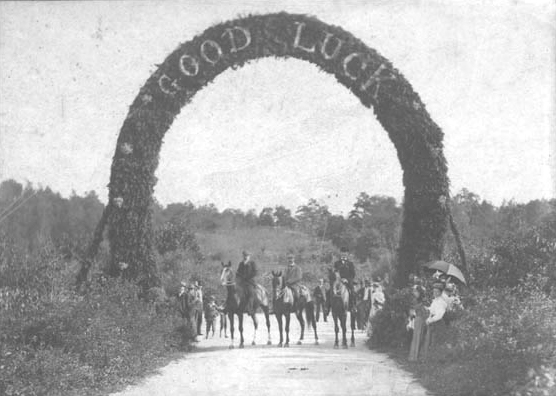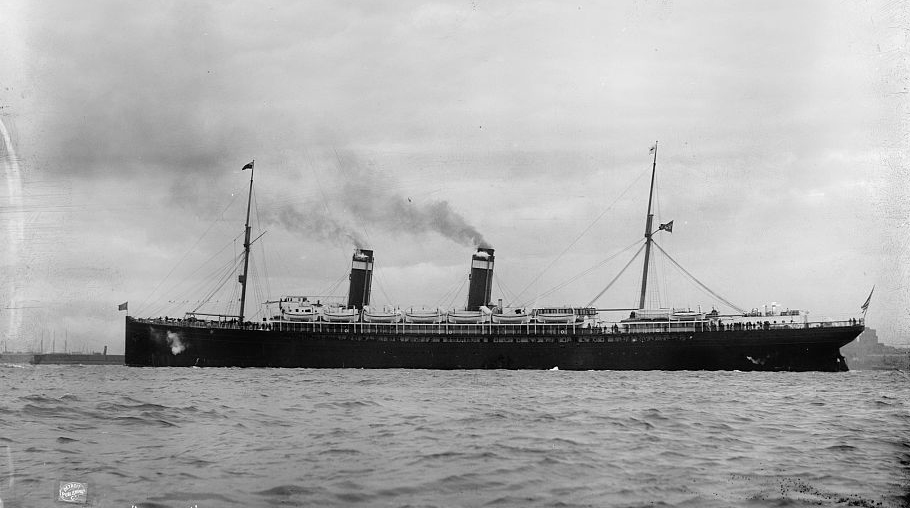
Bain Collection, Library of Congress
Bibliophile, aesthete, and patron of the arts, George Washington Vanderbilt was twenty-five years old in 1888 when he visited the mountainous region of Western North Carolina with his beloved mother and became enthralled with the notion of acquiring land in the area.

Natalie Bayard Brown Papers, Brown University Library
Orphaned as a child and not endowed with great wealth, Edith Stuyvesant Dresser nevertheless claimed lineage to several of the famous founding families of New York City.

Library of Congress
To bring his dream to fruition, Vanderbilt hired two giants in the field of design. Frederick Law Olmsted was the father of landscape architecture—renowned for his work on New York City’s Central Park and many other great American public spaces. Architect Richard Morris Hunt had designed grand homes for wealthy families, but had also created public spaces and monuments as well—like the pedestal for the Statue of Liberty. Poignantly, Biltmore became one of the last works for both men.

Library of Congress
Library of Congress
Gifford Pinchot served as Biltmore’s forester before becoming the first chief of the U.S. Forest Service.

Schenck: Carl Alwin Schenck Papers, North Carolina State University Libraries, Raleigh, NC
His successor at Biltmore was German-born forester and founder of the Biltmore Forest School, Carl Schenck.

Natalie Bayard Brown Papers, Brown University Library
Soon after a transatlantic meeting aboard the steamship St. Paul, George and Edith—shown here in her 1898 engagement photo—wed and returned to a grand welcome by the staff of Biltmore Estate.

Carl Alwin Schenck Papers, North Carolina State University Libraries, Raleigh, NC

Yale Collection of American Literature, Beinecke Rare Book and Manuscript Library, Yale University
George’s love of books was shared by two chums: Paul Leicester Ford was a noted man of letters; William B. Osgood Field was a sportsman, adventurer, and engineer.

The Grolier Club

Nace Brock Photographic Collection, North Carolina Collection Photographic Archives, The Wilson Library, University of North Carolina at Chapel Hill
Cornelia, George and Edith’s daughter, is seen here with her mother. She inherited her parents’ compassion for the less fortunate.
North Carolina Collection, Pack Memorial Public Library, Asheville, NC
The 1916 flood dealt a severe blow to Biltmore’s nurseries, forcing their closure. George and Edith’s early investment in the community ultimately led to Biltmore Industries, purveyors of locally crafted fine wood carvings and homespun fabrics.
North Carolina Collection, Pack Memorial Public Library, Asheville, NC
North Carolina Collection, Pack Memorial Public Library, Asheville, NC
North Carolina Collection, Pack Memorial Public Library, Asheville, NC
Influenced by the burgeoning Arts and Crafts movement, the sumptuous Grove Park Inn—built on Sunset Mountain in Asheville—signaled an aesthetic shift from Gilded Age opulence. The inn was financed by E. W. Grove’s “chill tonic” empire. Billed as a cure for malaria, the quinine-infused concoction promised to make “children and adults as fat as pigs.”
The Roanoke Beacon, Plymouth, NC, 1901

Harris & Ewing Collection, Library of Congress
Cornelia’s 1924 wedding to British diplomat John Francis Amherst Cecil may well have been the most glamorous wedding ever to take place in the small North Carolina mountain town.
Harris & Ewing Collection, Library of Congress

Harris & Ewing Collection, Library of Congress
Library of Congress
An 1895 postcard shows how the estate appeared in its infancy, when Olmsted’s trees were still immature. The house appears on the right hill; the white structures to the left are the greenhouses of the lower walled garden.
North Carolina Collection, Pack Memorial Public Library, Asheville, NC
Work on the house progressed for roughly six years. Stonecutters—shown perched on ladders and scaffolds—were employed by James Sinclair & Company, a New York contractor that had built Vanderbilt homes in that city. A special rail spur, constructed at a cost to George of nearly $80,000, ferried men and materials via locomotive to the worksite each morning.
North Carolina Collection, Pack Memorial Public Library, Asheville, NC

Library of Congress
Images culled from the personal scrapbooks of architect Richard Morris Hunt show the Palm Court, George’s indoor garden;

Library of Congress
the fireplace in his personal library;

Library of Congress
and the equally stunning fireplace just outside his bookish lair, in the tapestry room.
Library of Congress
Knowing that the estate would one day grow into his vision, Olmsted planned for astonishingly diverse views. Formal sweeping vistas contrasted with glimpses of the house framed by mature vegetation and watery reflections.
Library of Congress
According to Olmsted’s plan, the approach to the house is an exercise in sustained suspense—a long, winding trip through a canopied forest beginning at the Lodge Gate that ultimately leads to unexpected grandeur. This portion of the façade mimics the staircase inside the house. Look closely and you’ll spy statues of St. Louis and St. Joan of Arc.

Library of Congress
Library of Congress
No home in the United States has ever come close to beating the size of the 175,000-square-foot Biltmore House. But its greatest achievement may well be the fact that it has survived into the twenty-first century while other Gilded Age masterpieces have long since disappeared.






























